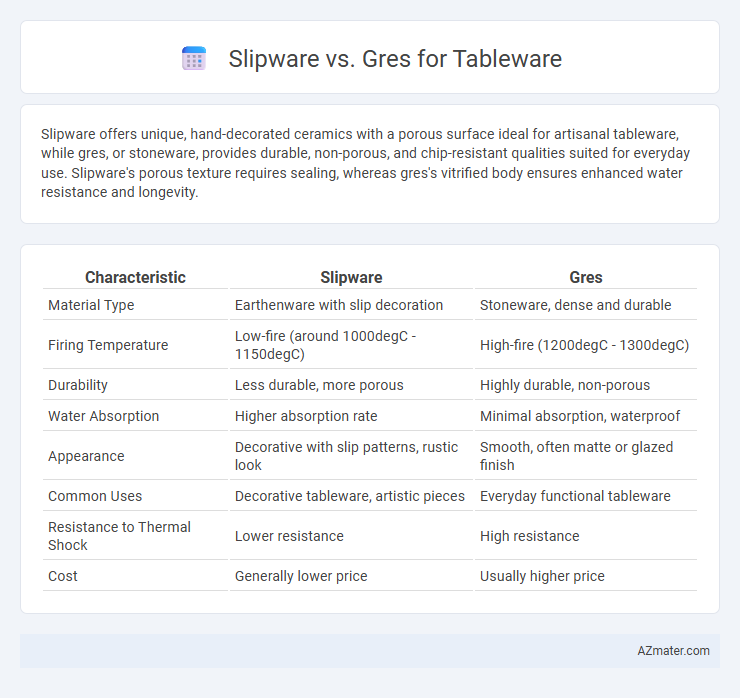Slipware offers unique, hand-decorated ceramics with a porous surface ideal for artisanal tableware, while gres, or stoneware, provides durable, non-porous, and chip-resistant qualities suited for everyday use. Slipware's porous texture requires sealing, whereas gres's vitrified body ensures enhanced water resistance and longevity.
Table of Comparison
| Characteristic | Slipware | Gres |
|---|---|---|
| Material Type | Earthenware with slip decoration | Stoneware, dense and durable |
| Firing Temperature | Low-fire (around 1000degC - 1150degC) | High-fire (1200degC - 1300degC) |
| Durability | Less durable, more porous | Highly durable, non-porous |
| Water Absorption | Higher absorption rate | Minimal absorption, waterproof |
| Appearance | Decorative with slip patterns, rustic look | Smooth, often matte or glazed finish |
| Common Uses | Decorative tableware, artistic pieces | Everyday functional tableware |
| Resistance to Thermal Shock | Lower resistance | High resistance |
| Cost | Generally lower price | Usually higher price |
Introduction to Slipware and Gres Tableware
Slipware tableware features a decorative clay slip coating that creates unique textures and vibrant colors, prized for its artisanal and tactile qualities. Gres tableware, made from high-fired stoneware clay, offers exceptional durability, chip resistance, and a sleek, minimalist aesthetic suitable for everyday use. Both materials provide distinct advantages, with slipware highlighting artistic expression and gres emphasizing functionality and longevity.
Historical Background of Slipware and Gres
Slipware, originating in the Middle Ages, features a decorative technique where liquid clay slip is applied to pottery before firing, widely used across Europe for ornamental tableware. Gres, or stoneware, evolved later with high-temperature firing processes, creating denser, more durable tableware suited for everyday use, gaining prominence during the Industrial Revolution. Both materials reflect distinct historical advancements in ceramic technology and aesthetic preferences shaping modern tableware.
Material Composition: Slipware vs Gres
Slipware is characterized by a porous earthenware clay body coated with a liquid clay slip that creates decorative patterns, resulting in a softer, less vitrified surface ideal for rustic tableware. Gres, or stoneware, is composed of a denser, highly vitrified feldspathic clay fired at higher temperatures, producing a non-porous, durable, and chip-resistant material preferred for functional and everyday use tableware. The key difference in material composition lies in slipware's lower firing temperature and porous earthenware base versus gres's high-fired, vitrified stoneware clay body, impacting durability and water resistance.
Crafting Techniques: Slipware and Gres Explained
Slipware tableware involves coating pottery with liquid clay slip before firing, allowing intricate designs and vibrant colors to emerge through techniques like trailing, painting, or dipping. Gres, or stoneware, is crafted from high-fired, dense clay resulting in durable, non-porous pieces with a smooth, often matte finish, typically formed by wheel-throwing or molding. Slipware emphasizes decorative surface treatment, while Gres prioritizes strength and functional resilience in everyday tableware.
Aesthetic Qualities and Design Differences
Slipware tableware showcases rich, tactile textures with hand-applied slip decorations that create one-of-a-kind, artisanal patterns, appealing to lovers of rustic and traditional aesthetics. Gres, often made from stoneware clay, offers sleek, minimalist design options with smooth surfaces and subtle glazing, emphasizing modern, refined elegance. The visual contrast between slipware's organic, handcrafted look and Gres's clean, uniform finish highlights differing design philosophies in functional art.
Durability and Functional Performance
Slipware features a decorative slip coating that adds aesthetic appeal but can be more prone to chipping and wear under heavy use, making it less durable than gres. Gres, a type of stoneware fired at higher temperatures, offers superior hardness, resistance to scratches, and thermal shock, enhancing its durability and functional performance for everyday tableware. Its non-porous surface ensures better hygiene and ease of cleaning, making gres a preferred choice for practical, long-lasting dinnerware.
Suitability for Everyday Tableware Use
Slipware offers a unique, handcrafted aesthetic with a durable yet porous surface, ideal for casual everyday use where charm and artistic appeal are valued. Gres, or stoneware, provides superior hardness, chip resistance, and non-porosity, making it highly suitable for frequent, heavy-duty tableware handling and dishwasher use. The choice between slipware and gres hinges on balancing artisanal design preference against practicality and maintenance requirements in daily dining scenarios.
Maintenance and Care Requirements
Slipware tableware requires gentle hand washing to preserve its decorative slip coating and prevent chipping, avoiding abrasive cleaners and sudden temperature changes. Gres tableware, made from vitrified stoneware, is highly durable and dishwasher-safe, offering superior resistance to scratches and stains while requiring minimal maintenance. Regular care for slipware emphasizes delicate handling, whereas gres is suited for daily use with straightforward cleaning routines.
Environmental Impact and Sustainability
Slipware tableware, crafted from ceramics coated with a slip layer, tends to use natural clay and traditional firing methods that often have a lower carbon footprint compared to gres, a type of porcelain stoneware fired at higher temperatures. Gres tableware, characterized by its dense, non-porous structure, usually requires more energy-intensive production processes but offers greater durability and longevity, reducing waste over time. Prioritizing sustainability, slipware favors biodegradable materials and artisanal techniques, while gres's long lifecycle compensates for higher initial environmental costs through reduced replacement frequency.
Choosing Between Slipware and Gres: Key Considerations
Choosing between slipware and gres for tableware involves evaluating durability and aesthetic appeal; gres, a high-fired stoneware, offers superior strength and chip resistance ideal for daily use, while slipware showcases artistic surface decoration through liquid clay slip, enhancing visual appeal but requiring gentle handling. Consider maintenance needs as gres is typically dishwasher and microwave safe, whereas slipware's decorative layer may demand hand washing to preserve intricate designs. The decision hinges on balancing practical durability with artistic expression to suit specific lifestyle and usage preferences.

Infographic: Slipware vs Gres for Tableware
 azmater.com
azmater.com